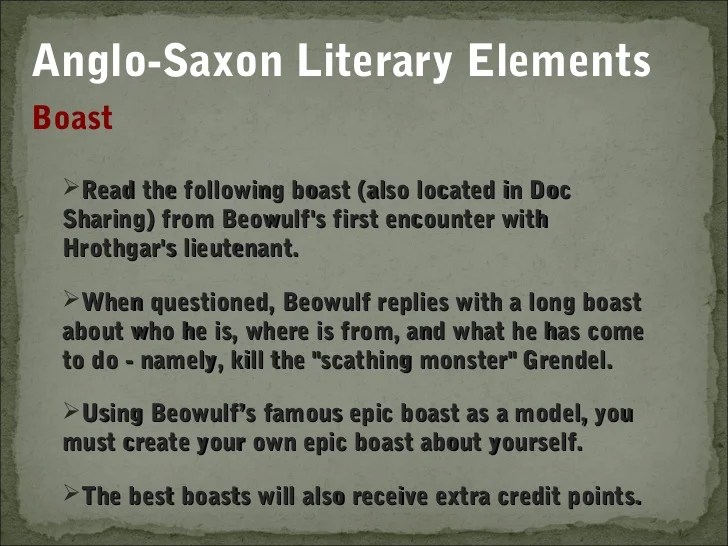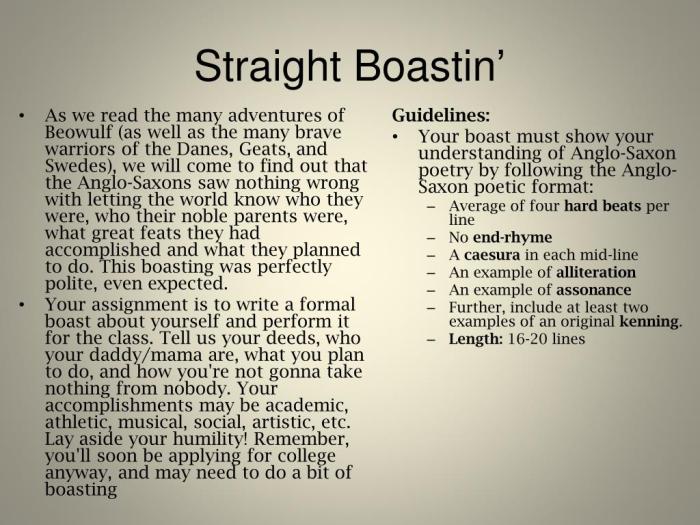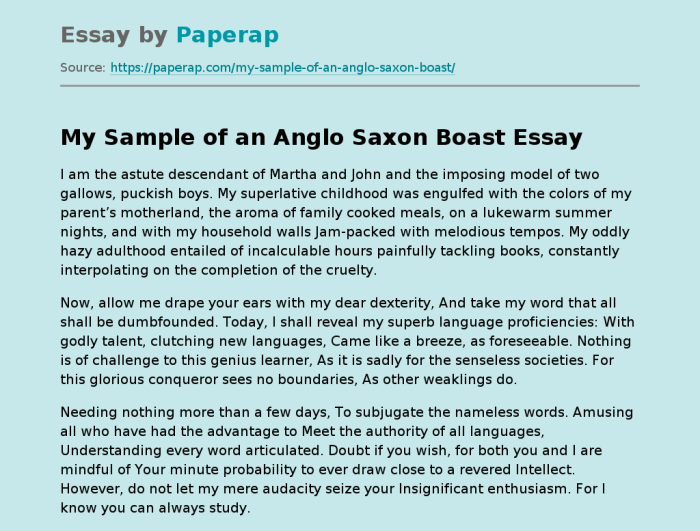Examples of anglo saxon boasts – Embark on a literary odyssey as we delve into the captivating realm of Anglo-Saxon boasts, a testament to the vibrant culture and indomitable spirit of our ancestors. From the epic verses of “Beowulf” to the tapestry of modern literature, these boasts reverberate with a timeless resonance that continues to inspire and intrigue.
In this comprehensive exploration, we unravel the significance, structure, and functions of Anglo-Saxon boasts, tracing their enduring influence on the literary landscape and beyond.
Anglo-Saxon Boasts in Poetry

Anglo-Saxon boasts played a significant role in the oral tradition and written poetry of the Anglo-Saxon era. These boasts were not mere exaggerations but served specific cultural and social functions.
Anglo-Saxon poetry, such as “Beowulf,” featured heroes who engaged in elaborate boasts to display their strength, courage, and lineage. These boasts served several purposes: they established the hero’s reputation, intimidated opponents, and reinforced the warrior ethos of the Anglo-Saxon society.
In Anglo-Saxon literature, boasts were often used to demonstrate a warrior’s strength and bravery. These boasts could take many forms, such as claiming to have slain a certain number of enemies or to have performed a particularly daring feat. For example, in the epic poem Beowulf, the hero boasts of having defeated the monster Grendel.
If you’re looking for more information on this topic, you might find a tale of two gases answer key helpful. Additionally, Anglo-Saxon boasts often included references to the warrior’s lineage and ancestry.
Examples of Anglo-Saxon Boasts
In “Beowulf,” the titular hero boasts of his past victories and his willingness to face the monster Grendel:
“I have heard how Grendel has been terrifying your hall-troops… I will fight the monster face to face… I do not fear his might.”
Another example comes from the poem “The Battle of Maldon,” where the Anglo-Saxon warrior Byrhtnoth boasts of his lineage and determination:
“I am old and gray-haired, but I will not flee from the battlefield. My ancestors were brave warriors, and I will not disgrace their memory.”
Types of Anglo-Saxon Boasts: Examples Of Anglo Saxon Boasts
Anglo-Saxon boasts were a way for warriors to display their prowess and accomplishments. These boasts often took the form of poetry, and they were often used to celebrate victories in battle. There were many different types of Anglo-Saxon boasts, but they can be broadly categorized into three main types: physical prowess, lineage, and wealth.
Physical Prowess
Anglo-Saxon warriors often boasted about their physical prowess. They would brag about their strength, speed, and agility. They would also boast about their skills in battle, such as their ability to wield a sword or axe.
- “I am a mighty warrior, strong and brave.”
- “I can run faster than the wind.”
- “I can jump higher than a house.”
- “I can wield a sword like no other.”
- “I have never been defeated in battle.”
Lineage
Anglo-Saxon warriors also often boasted about their lineage. They would trace their ancestry back to famous heroes and kings. They would also boast about the accomplishments of their ancestors.
- “I am descended from a long line of warriors.”
- “My father was a great warrior, and my grandfather was a king.”
- “My ancestors have fought in many battles and won many victories.”
- “I am proud of my lineage, and I will never disgrace my family name.”
Wealth, Examples of anglo saxon boasts
Anglo-Saxon warriors also often boasted about their wealth. They would brag about their possessions, such as their land, their gold, and their slaves. They would also boast about their ability to provide for their family and their followers.
- “I am a wealthy man, with much land and gold.”
- “I have many slaves to serve me.”
- “I can provide for my family and my followers.”
- “I am never in want of anything.”
These are just a few examples of the many different types of Anglo-Saxon boasts. These boasts were a way for warriors to display their prowess and accomplishments, and they were an important part of Anglo-Saxon culture.
Structure and Form of Anglo-Saxon Boasts

Anglo-Saxon boasts were highly structured and formulaic, with a specific form that contributed to their impact and effectiveness. They often followed a pattern of challenge and response, with the speaker boasting of their accomplishments and daring others to match them.
One of the most striking features of Anglo-Saxon boasts is their use of alliteration, the repetition of consonant sounds at the beginning of words or stressed syllables. This device creates a sense of rhythm and flow, making the boasts more memorable and easier to recite.
For example, in the following boast, the alliteration of the “w” sound emphasizes the speaker’s strength and prowess:
“I am a warrior who wields the sword,With wounds that weep and wounds that roar.”
Anglo-Saxon boasts also make extensive use of kennings, metaphorical phrases that describe something in a vivid and indirect way. Kennings were often used to describe the speaker’s enemies or their own accomplishments. For example, the following kenning describes a sword as a “battle-flame”:
“I wield the battle-flame, a blade of fire,That cuts through flesh and bone with dire.”
The use of alliteration and kennings in Anglo-Saxon boasts not only adds to their aesthetic appeal but also serves to enhance their impact and effectiveness. These poetic devices create a sense of rhythm and flow, making the boasts more memorable and easier to recite.
They also add to the boasts’ vividness and imagery, making them more engaging and persuasive.
Structure of Anglo-Saxon Boasts
Anglo-Saxon boasts typically followed a three-part structure:
- Challenge:The speaker begins by issuing a challenge to others, daring them to match their accomplishments.
- Boast:The speaker then boasts of their own accomplishments, often in exaggerated terms.
- Response:The speaker ends by challenging others to respond to their boast, or by stating that they are the greatest.
This structure creates a sense of tension and drama, as the speaker builds up to their final boast and then challenges others to respond.
Formulaic Language
Anglo-Saxon boasts also used a number of formulaic phrases and expressions. These phrases were often repeated from one boast to another, and they helped to create a sense of unity and tradition. Some of the most common formulaic phrases include:
- “I am the greatest.”
- “I have never been defeated.”
- “I am the strongest warrior.”
- “I am the most skilled hunter.”
These phrases served to emphasize the speaker’s confidence and superiority, and they helped to create a sense of authority and power.
The Function of Anglo-Saxon Boasts

Anglo-Saxon boasts served a variety of functions within their society, ranging from establishing reputation and challenging rivals to building camaraderie and boosting morale.
One of the primary functions of Anglo-Saxon boasts was to establish the speaker’s reputation and status within the community. By boasting of their accomplishments, warriors and leaders sought to demonstrate their strength, bravery, and prowess, thereby enhancing their social standing and gaining the respect of others.
Challenging Rivals
Anglo-Saxon boasts were also used to challenge rivals and assert dominance. Warriors would often engage in verbal duels, known as “flytings,” in which they exchanged insults and boasts, attempting to outdo each other in terms of wit and verbal aggression.
These flytings could serve as a means of settling disputes, demonstrating one’s superiority, and humiliating one’s opponent.
Building Camaraderie
In addition to their competitive function, Anglo-Saxon boasts also played a role in building camaraderie and fostering a sense of unity within the community. Warriors would often boast of their shared experiences and accomplishments, creating a sense of shared identity and belonging.
These boasts helped to strengthen the bonds between warriors and reinforce the importance of loyalty and cooperation.
Anglo-Saxon Boasts in Modern Culture

Anglo-Saxon boasts have left an enduring mark on modern culture, shaping literary works, cinematic storytelling, and other forms of popular entertainment. These boasts, characterized by their bold proclamations and exaggerated feats, continue to resonate with audiences today, offering insights into the values and aspirations of our time.
Influence on Modern Literature
The influence of Anglo-Saxon boasts can be seen in the works of renowned authors such as J.R.R. Tolkien and George R.R. Martin. Tolkien’s epic fantasy novels, particularly “The Lord of the Rings,” feature characters who engage in boastful exchanges, mirroring the tradition of Anglo-Saxon warriors.
Martin’s “A Song of Ice and Fire” series also incorporates elements of Anglo-Saxon boasting, with characters boasting of their lineage, prowess, and conquests.
In Film and Television
Anglo-Saxon boasts have found their way into the realm of film and television. The popular television series “Game of Thrones,” based on Martin’s novels, features characters who frequently engage in boastful dialogue, reminiscent of the exchanges found in Anglo-Saxon literature.
The film “Beowulf” (2007) is a direct adaptation of the Anglo-Saxon epic poem, bringing the boasting traditions of the original text to the big screen.
Relevance and Significance
The continued presence of Anglo-Saxon boasts in modern culture speaks to their enduring relevance. These boasts provide a glimpse into the values and aspirations of past societies and continue to inspire and entertain audiences today. They serve as a reminder of the power of language and the human desire for recognition and self-aggrandizement.
Key Questions Answered
What is the significance of boasting in Anglo-Saxon poetry?
Boasting played a crucial role in Anglo-Saxon poetry, serving as a means of establishing reputation, challenging rivals, and fostering camaraderie among warriors.
How did Anglo-Saxon boasts reflect the cultural and social context of the time?
Anglo-Saxon boasts often reflected the values and beliefs of the society, emphasizing physical prowess, lineage, and wealth as markers of status and honor.
What are some examples of Anglo-Saxon boasts from “Beowulf”?
In “Beowulf,” the titular hero boasts of his swimming prowess, his victories in battle, and his unwavering loyalty to his king.